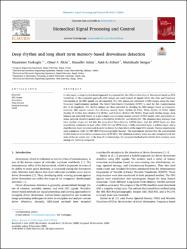| dc.contributor.author | Türkoğlu, Muammer | |
| dc.contributor.author | Alçin, Ömer Faruk | |
| dc.contributor.author | Aslan, Muzaffer | |
| dc.contributor.author | Al-Zebari, Adel | |
| dc.contributor.author | Şengur, Abdülkadir | |
| dc.date.accessioned | 2021-09-27T11:55:08Z | |
| dc.date.available | 2021-09-27T11:55:08Z | |
| dc.date.issued | 2021 | en_US |
| dc.identifier.citation | Turkoglu, M., Alcin, O. F., Aslan, M., Al-Zebari, A., & Sengur, A. (2021). Deep rhythm and long short term memory-based drowsiness detection. Biomedical Signal Processing and Control, 65, 102364. | en_US |
| dc.identifier.issn | 1746-8094 | |
| dc.identifier.issn | 1746-8108 | |
| dc.identifier.uri | https://doi.org/10.1016/j.bspc.2020.102364 | |
| dc.identifier.uri | https://hdl.handle.net/20.500.12899/442 | |
| dc.description.abstract | In this paper, a deep-rhythm-based approach is proposed for the efficient detection of drowsiness based on EEG recordings. In the proposed approach, EEG images are used instead of signals where the time and frequency information of the EEG signals are incorporated. The EEG signals are converted to EEG images using the time-frequency transformation method. The Short-Time-Fourier-Transform (STFT) is used for this transformation due to its simplicity. The rhythm images are then extracted by dividing the EEG images based on frequency intervals. EEG signals contain five rhythms, namely Delta rhythm (0–4 Hz), Theta rhythm (4–8 Hz), Alpha rhythm (8–12 Hz), Beta rhythm (12–30 Hz), and Gamma rhythm (30–50 Hz). From each rhythm image, deep features are extracted based on a pre-trained convolutional neural network (CNN) model, with pre-trained residual network (ResNet) models such as ResNet18, ResNet50, and ResNet101. The obtained deep features from each rhythm image are fed into the Long-Short-Term-Memory (LSTM) layer, and the LSTM layers are then sequentially connected to each other. After the last LSTM layer, a fully-connected layer, a softmax layer, and a classification layer are employed in order to detect the class labels of the input EEG signals. Various experiments were conducted with the MIT/BIH Polysomnographic Dataset. The experiments showed that the concatenated ResNet features achieved an accuracy score of 97.92%. The obtained accuracy score was also compared with the state-of-the-art scores and, to the best of our knowledge, the proposed method achieved the best accuracy score among the methods compared. | en_US |
| dc.language.iso | eng | en_US |
| dc.publisher | Elsevier | en_US |
| dc.relation.isversionof | 10.1016/j.bspc.2020.102364 | en_US |
| dc.rights | info:eu-repo/semantics/embargoedAccess | en_US |
| dc.subject | EEG images | en_US |
| dc.subject | Drowsiness | en_US |
| dc.subject | Deep features | en_US |
| dc.subject | Residual networks | en_US |
| dc.subject | LSTM | en_US |
| dc.title | Deep rhythm and long short term memory-based drowsiness detection | en_US |
| dc.type | article | en_US |
| dc.authorid | 0000-0002-2917-3736 | en_US |
| dc.department | MTÖ Üniversitesi, Mühendislik ve Doğa Bilimleri Fakültesi, Elektrik-Elektronik Mühendisliği Bölümü | en_US |
| dc.contributor.institutionauthor | Alçin, Ömer Faruk | |
| dc.identifier.volume | 65 | en_US |
| dc.identifier.startpage | 1 | en_US |
| dc.identifier.endpage | 7 | en_US |
| dc.relation.journal | Biomedical Signal Processing and Control | en_US |
| dc.relation.publicationcategory | Makale - Uluslararası Hakemli Dergi - Kurum Öğretim Elemanı | en_US |


















